Disclosure: This article contains affiliate links and as an Amazon Associate, we earn from qualifying purchases made through our links.
The most loved music-listening medium that was almost forgotten has started becoming everyone’s favorite once again.
Well, in the past few years, we have seen a sudden spike in the popularity of vinyl records, and thousands of people are entering the vinyl world and purchasing their first-ever turntable or vinyl record.
Well, I believe the reason behind the resurgence of vinyl is not only limited to the music experience, but its attractive looks too.
In my whole vinyl journey, I have met many people who are not in the vinyl world but somewhat related to it, like my neighbor John. He doesn’t know anything about records and turntables, but he has decorated his bedroom and living room walls with records, and trust me, the appearance of his room is superb.
After seeing his room, I felt a spark inside, telling me to do the same with my room, too. So, I started searching for ways to decorate my room. But before ordering products, I needed to give them the exact size of the record cover, which I didn’t know about. So, I took my dad’s measuring tape and measured my vinyl record’s dimensions and their outer/inner sleeve size.
Knowing the sizes not only helped with the decoration but also while shipping my records, checking them for compatibility with the turntables, and creating proper record storage boxes, which saved my records from warping.
Well, all this happened to me in 2012 when the vinyl was dying, but since the resurgence, I have been asked questions by the Turntablewave audience and my friends like, How big, tall, or wide are vinyl records? What are the dimensions of vinyl records? What is the standard size of a vinyl record cover? many times. These questions make me think that people aren’t getting their answers from the information available online, so I decided to write an article and educate my fellow people. In this article, I will explain everything to you.
So, let’s start.

AT-LP60X-BK with Edifier R1280DB speakers
A beginner-friendly combo to kickstart your vinyl journey — no extra phono preamp or amplifier needed!
- Beginner-friendly
- Complete plug-and-play setup
- Fully automatic turntable
- High-fidelity sound
- Sleek design and easy to use
Standard Sizes Of Records
For better understanding, I have shared the record information according to different sizes.
1) 12-inch (long-playing or LPs)
2) 10-inch (standard play or SPs)
3) 7-inch (extended play or EPs)
Interesting reads:
12-inch vinyl record (long-playing or LPs)
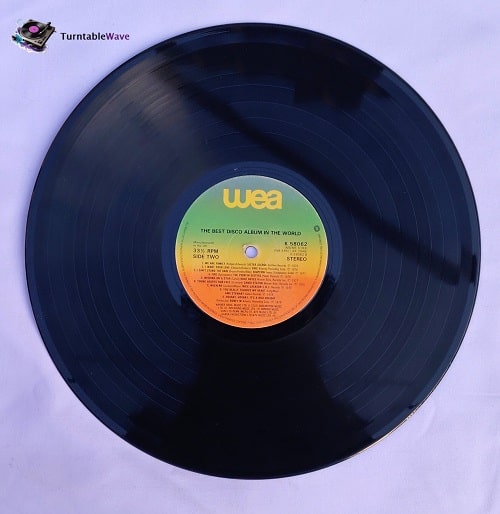
LP Record dimensions
The diameter of the 12-inch record is 30.2 cm or 11.88 inches.
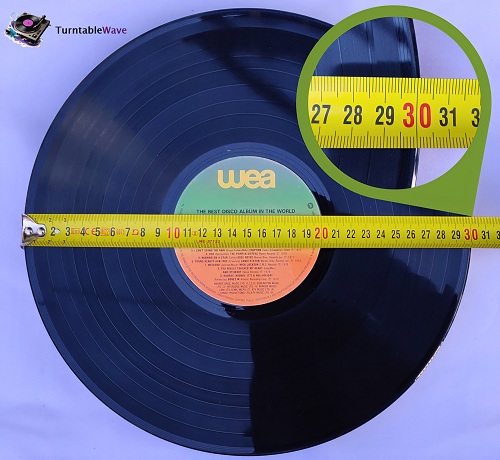
Well, if we convert 12 inches into cm, the result we get is 30.48 cm, but in reality, the 12-inch record diameter is 30.2 cm, i.e., 11.88 inches.
The album’s cover dimensions
Outer Sleeve:
The 12-inch outer cover can be 12.24 to 12.37 inches (31.08 to 31.41 cm) tall and 12.24 to 12.37 inches (31.08 to 31.41 cm) wide.
Here is the measurement of my album:
The length is 31.4 cm (12.36 inches).
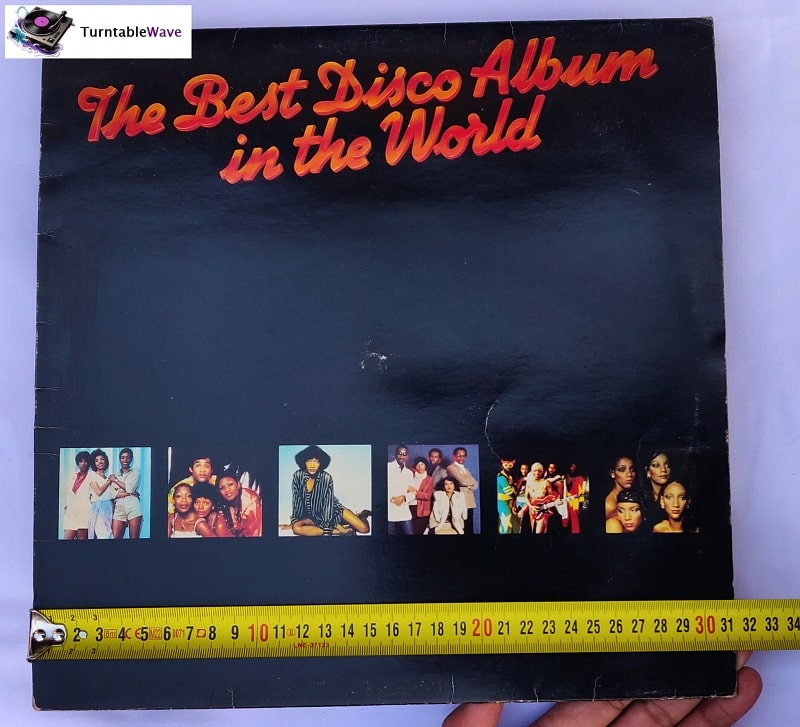
The width is 31.3 cm (12.32 inches).
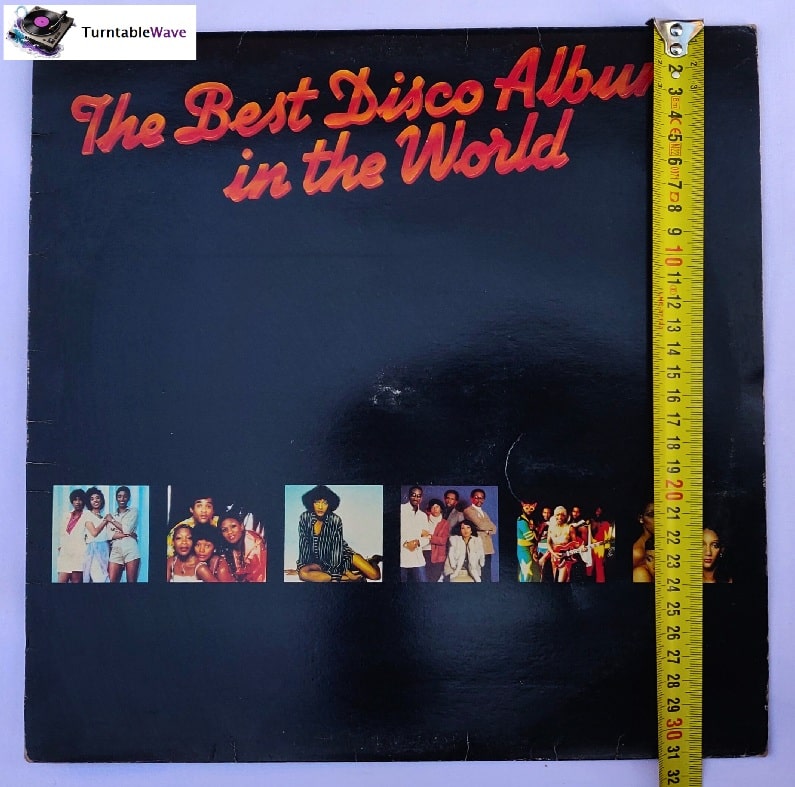
Inner Sleeve:
The length of my LP’s inner sleeve is 30.8 cm (12.12 inches), and the width is 30.3 cm (11.9 inches). Considering all LPs, the 12-inch inner cover can be 11.9 to 12.15 inches (31.1 to 31.8 cm) tall and 11.9 to 12.15 inches (31.1 to 31.8 cm) wide.
Weight:
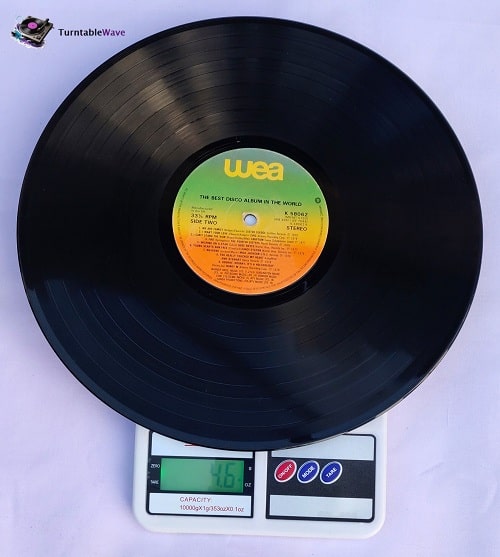
More information
| Speed | 33⅓, 45 and 16⅔ RPM |
| Playback time | 33⅓ (Up to 25 minutes per side), 45 (Up to 18 minutes per side), and 16⅔ (Up to 20 minutes) |
| Weight | Averages around 4.9 oz or 6.3 oz |
| Center hole diameter | 0.23 cm |
| Used for | Albums and singles, whereas 16⅔ were used for broadcasts |
| Material manufactured with | 33s and 45s are manufactured with vinyl, whereas 16⅔ were manufactured with shellac or cardboard. |
10-inch shellac record (standard play or SPs)
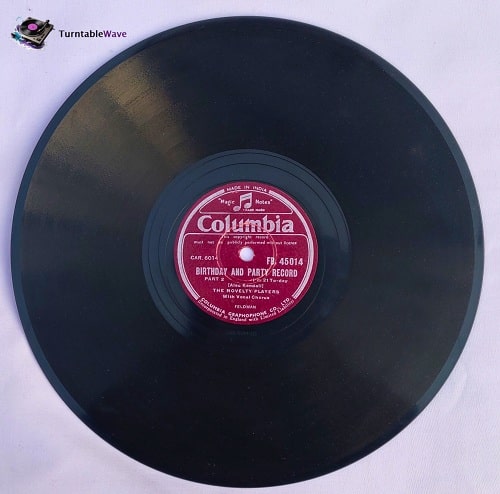
SP Record size
The diameter of the 10-inch record is 25.1 cm or 9.88 inches.
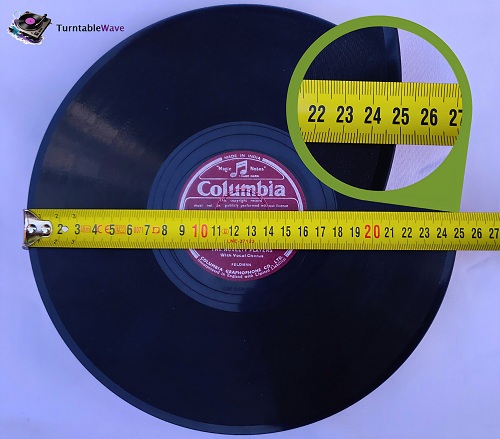
The actual diameter of the 78 record is also less than its supposed to be. If we convert 10 inches to cm, we get 25.4 cm, but in reality, the 10-inch record diameter is 25.1 cm, i.e., 0.3 cm less.
Record cover
The 10-inch cover can be 10.1 inches (25.7 cm) to 10.62 inches (26.9 cm) tall and 10.1 inches (25.7 cm) to 10.62 inches (26.9 cm) wide.
Weight:
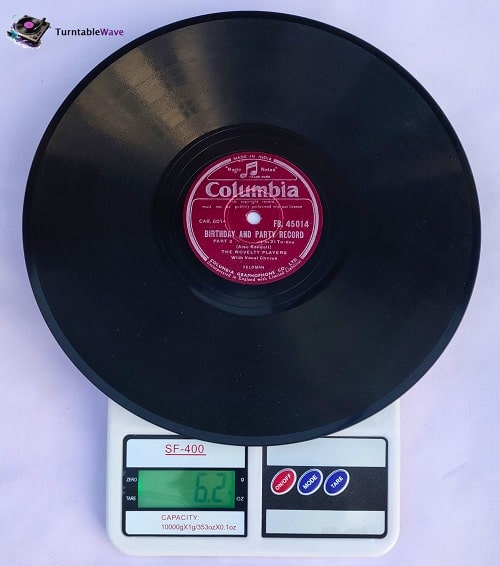
More information
| Speed | 78 RPM |
| Playback time | Up to 5 minutes per side |
| Weight | Averages around 6.2 oz |
| Center hole diameter | 0.23 cm |
| Used for | Albums and singles |
| Material manufactured with | Vinyl or shellac |
7-inch vinyl record (extended play or EPs)
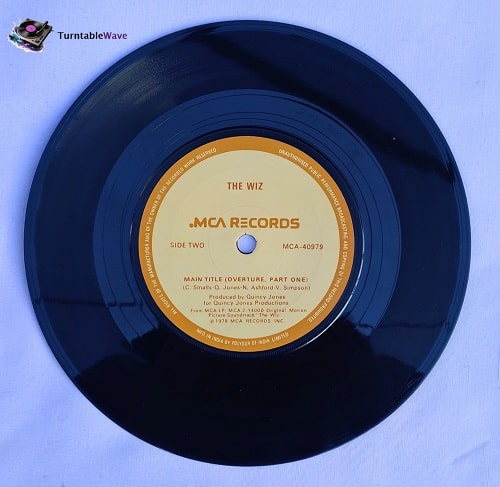
EP record dimensions
The diameter of the 7-inch record is 17.4 cm or 6.85 inches.
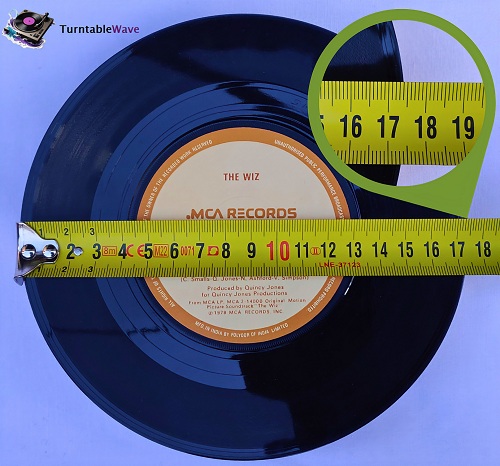
Similar to 12-inch and 10-inch records, if we convert 7 inches into cm, the result we get is 17.8 cm, but in reality, the 7-inch record diameter is 17.4 cm, i.e., 0.38 cm less.
Record sleeve size
The sleeves can be 7.04 to 7.25 inches (17.9 to 18.41 cm) tall and 7.04 to 7.25 inches (17.9 to 18.41 cm) wide.
Here is the measurement of my EP’s sleeve:
The length is 17.9 cm (7.04 inches).
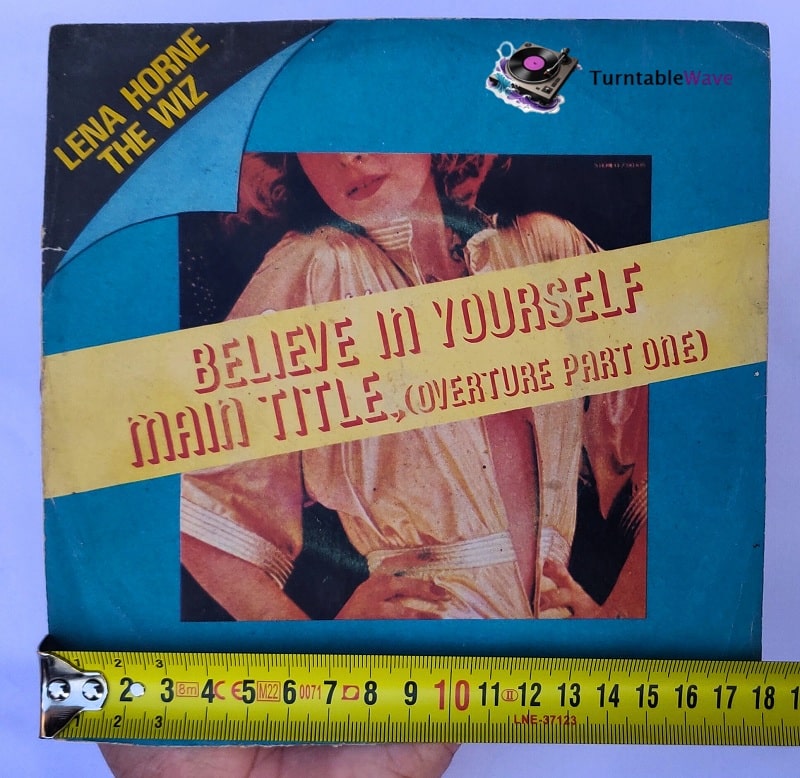
The width is 18.1 cm (7.12 inches).
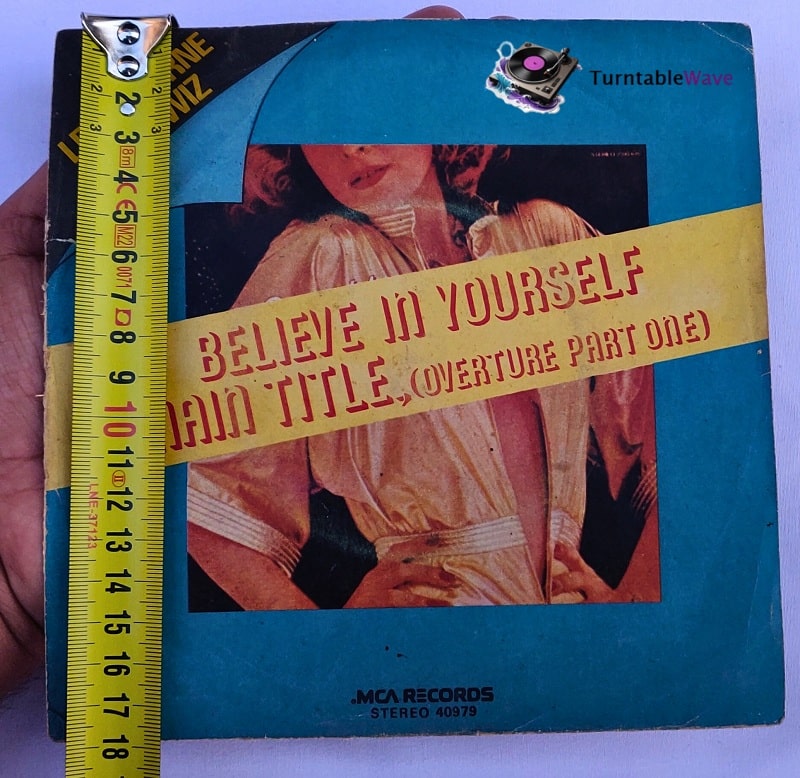
Weight:
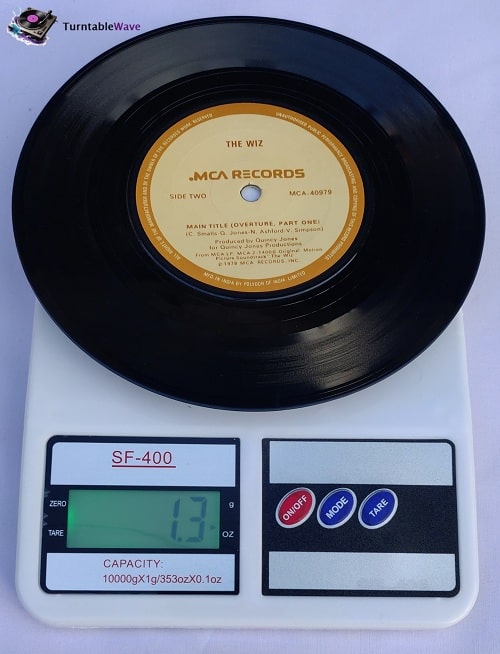
More information
| Speed | 45 RPM |
| Playback time | Up to 7 minutes per side |
| Weight | Averages around 1.4 oz |
| Center hole diameter | 1.216 cm |
| Used for | Singles |
| Material manufactured with | Vinyl |
Well, I have shared information on all the records, but there is one question that many people ask me, i.e., what’s the standard size of a vinyl record and its cover? So, let me share the answer with you guys.
What is the standard size of a vinyl record cover?
Well, the 12-inch and 7-inch are the standard sizes of vinyl records, and talking about their sleeve dimensions, the LP album cover size averages between 12.24 inches (31.08 cm) and 12.37 inches (31.41 cm), and the EP single cover size averages between 7.04 inches (17.9 cm) and 7.25 inches (18.41 cm).
In the past, i.e., in the mid-20th century, the standard size was 10 inches, and the record cover size lies between 10.1 inches (25.7 cm) and 10.62 inches (26.9 cm).
Frequently Asked Questions:
Q1- What RPM is a 12-inch record?
If we talk about shellac records, the RPM of a 12-inch record can be 16⅔, 33⅓, 45, and 78 RPM, but talking about vinyl records, the 12-inch record can be 33⅓ RPM or 45 RPM.
Q2- What is the fastest vinyl record speed?
The fastest vinyl record speed is 45 RPM.
You might get confused with my answer because many people say that 78 RPM is the fastest vinyl record speed, but in reality, 78s are not vinyl records; these are shellac records. I recommend learning the difference between records through this article: 33 vs 45 vs 78 RPM.
Let me explain: Vinyl records are manufactured with PVC (polyvinyl chloride) material, while shellac records are manufactured with shellac material. Except for vinyl and shellac records, you might also hear about wax cylinders or Edison records.
So, the term record covers mainly three categories: vinyl records, shellac records, and wax cylinders. Now, I will share the fastest RPM based on all three categories.
In the records category, the fastest record speed is 160 RPM, i.e., wax cylinders or Edison records played on phonographs. In the shellac record category, the fastest speed is 78 RPM, i.e., gramophone discs or SPs. In the last category, i.e., vinyl records, the fastest speed is 45 RPM (LPs or EPs).
Q3- Are all 7-inch records 45?
Nowadays, most of the 7-inch records are 45s, but it’s not a strict rule that 7 inches must be 45, so you might find some 7-inches that run at 33 RPM too.
Q4- Are all 12-inch records 33 RPM?
No, 12-inch records can be of 33, 45, and 78 RPM.
Q5- Are all record covers the same size?
No, the record cover sizes depend on the dimensions of vinyl/shellac records.
Well, we have shared vinyl records and cover dimensions, which you can use while shipping records and creating frames to decorate them on the walls, and you can also use the details for creating proper storage boxes and much more. If you still have any questions, feel free to comment below. We will get back to you as soon as possible.



Hi, out of all the record sizes you shared what’s the most common size?
Hi Nat, 12-inch record is the most common size.